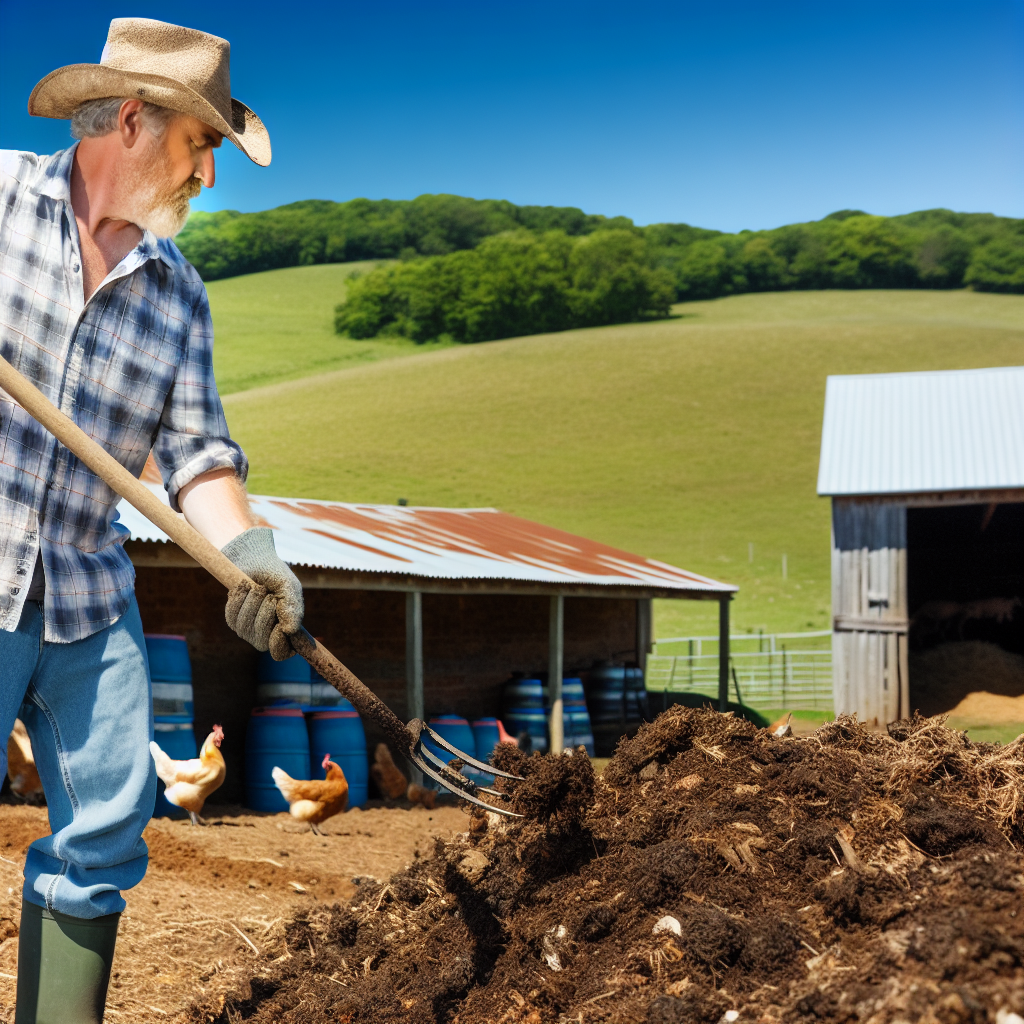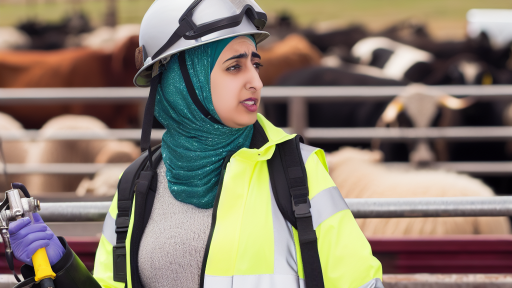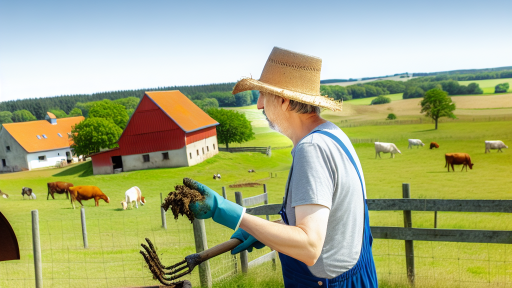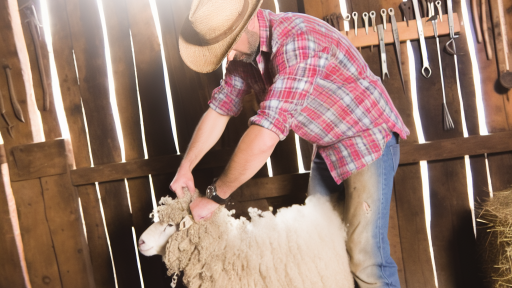Introduction to Composting Livestock Waste
Importance of Composting
Composting livestock waste revolutionizes waste management on farms.
It transforms waste into a valuable resource for soil health.
Farmers can reduce landfill waste and improve sustainability.
This process also enhances crop yields and soil structure.
Benefits of Composting Livestock Waste
Composting offers numerous environmental benefits.
It minimizes odors and pathogens associated with raw waste.
This practice conserves water by enhancing soil moisture retention.
Additionally, it lowers greenhouse gas emissions from decomposition.
Economic Advantages
Composting livestock waste can reduce fertilizer costs significantly.
Farmers often find that compost improves their bottom line.
It creates additional revenue opportunities through compost sales.
Moreover, the practice may qualify for environmental incentives.
Enhancing Soil Health
Using compost enriches soil fertility and microbial activity.
Healthy soil supports diverse plant life and biodiversity.
This ultimately leads to healthier livestock and crops.
Transform Your Agribusiness
Unlock your farm's potential with expert advice tailored to your needs. Get actionable steps that drive real results.
Get StartedFurthermore, compost provides essential nutrients and minerals.
Types of Livestock Waste Suitable for Composting
Composting livestock waste offers numerous benefits for farming practices.
However, not all types of livestock waste are suitable for composting.
Understanding the various materials can help optimize the composting process.
Manure from Common Livestock
Manure from cattle is rich in nutrients.
This type of waste decomposes well and contributes to soil health.
Poultry manure is another excellent option for composting.
It contains high nitrogen levels, promoting microbial activity.
Similarly, pig manure can also be composted effectively.
Other Organic Materials
In addition to manure, other organic materials enhance composting.
Straw and hay are commonly added to improve structure.
Such materials balance carbon-to-nitrogen ratios.
Vegetable scraps from farms can also be incorporated.
This helps recycle nutrients back into the soil.
Waste from Livestock Feed
Waste grain and leftover feed are valuable composting materials.
These by-products contribute essential nutrients.
Incorporating them can enhance the overall compost quality.
Including Bedding Materials
Bedding materials from livestock barns can be useful too.
Such bedding often consists of straw, wood shavings, or sawdust.
These materials enhance aeration during composting.
Furthermore, they provide additional carbon sources.
Avoiding Inappropriate Waste Types
It’s essential to avoid certain types of waste in your compost.
Never include waste from sick animals as it can spread disease.
In addition, plastics or synthetic materials must be excluded.
Showcase Your Farming Business
Publish your professional farming services profile on our blog for a one-time fee of $200 and reach a dedicated audience of farmers and agribusiness owners.
Publish Your ProfileThese items disrupt the natural composting process.
Selecting Optimal Livestock Waste for Composting
Selecting the right types of livestock waste is crucial.
Focusing on suitable materials maximizes the composting benefits.
By doing so, farmers can improve soil health and crop yields.
Essential Components of Composting
Understanding Carbon-to-Nitrogen Ratio
The carbon-to-nitrogen ratio is crucial in composting.
This ratio affects the decomposition process significantly.
Generally, an ideal ratio ranges from 25:1 to 30:1.
Carbon-rich materials, known as browns, provide energy.
Nitrogen-rich materials, referred to as greens, support microbial growth.
Balancing these materials accelerates composting.
For example, add straw or wood chips for carbon.
Conversely, use manure or fresh grass clippings for nitrogen.
Other Key Factors Influencing Composting
Moisture content plays a pivotal role in composting.
Maintaining moisture at around 40-60% promotes microbial activity.
Excess moisture can lead to anaerobic conditions.
This results in foul odors and slow decomposition.
Turning the compost regularly enhances aeration.
Aeration is vital for aerobic bacteria, which thrive with oxygen.
Impact of Temperature on Composting
Temperature significantly affects the efficiency of composting.
Composting generates heat as microorganisms break down organic matter.
Monitoring temperature helps identify stages in the process.
Typically, temperatures rise between 130°F and 160°F during active decomposition.
This heat is crucial for killing pathogens and weed seeds.
Once temperatures decline, mixing the compost can reinvigorate activity.
Type of Materials Suitable for Composting
Diverse materials contribute to nutrient-rich compost.
Fruit and vegetable scraps enrich the compost with nitrogen.
Kitchen waste, such as eggshells, can add calcium.
Avoid meat and dairy products to deter pests and odors.
Brown materials include dried leaves, cardboard, and straw.
Green materials encompass lawn clippings, coffee grounds, and manure.
Benefits of Properly Balanced Composting
Balanced composting boosts soil fertility and health.
It enhances soil structure and encourages water retention.
This process also supports beneficial microorganisms in the soil.
Furthermore, composting reduces landfill waste and greenhouse gases.
Ultimately, it promotes sustainable farming practices.
With time and care, compost can transform waste into valuable resources.
Find Out More: Safety Standards For Livestock Facilities
Methods of Composting Livestock Waste
Hot Composting Techniques
Hot composting generates high temperatures through active decomposition.
This process accelerates the breakdown of organic matter.
Typically, temperatures reach 130°F to 160°F.
Showcase Your Farming Business
Publish your professional farming services profile on our blog for a one-time fee of $200 and reach a dedicated audience of farmers and agribusiness owners.
Publish Your ProfileAs a result, pathogens and weed seeds are killed off effectively.
To implement hot composting, use a mix of nitrogen-rich and carbon-rich materials.
For instance, combine livestock manure with straw or dry leaves.
Maintain moisture to encourage microbial activity.
Turning the compost pile regularly ensures even decomposition.
Check the temperature weekly to monitor progress.
When the pile cools, it indicates that decomposition is complete.
Cold Composting Techniques
Cold composting is a slower, more passive method.
This technique relies on natural decomposition without high temperatures.
Cold composting is simple and requires less management.
To start, pile organic materials together without turning them.
Include a variety of wastes such as fruits, vegetables, and shredded paper.
Over time, soil organisms break down the materials.
Although slower, this method enriches the soil naturally.
It’s ideal for those who prefer a hands-off approach.
Comparing Hot and Cold Composting
Hot composting is faster and produces compost in weeks.
In contrast, cold composting may take months to yield finished compost.
Hot composting requires more attention and turning of the pile.
Cold composting allows for less frequent intervention.
Choose a method based on your available time and resources.
Both methods ultimately help reduce livestock waste while enriching the soil.
Discover More: Temperature Control In Livestock Facilities
Site Selection and Preparation for Composting Operations on a Farm
Choosing the Right Location
Selecting an appropriate site for composting is crucial.
Look for areas with good drainage to prevent waterlogging.
Avoid locations near water bodies to reduce contamination risks.
Ensure the site is easily accessible for waste transportation.
Consider proximity to livestock operations to streamline waste collection.
Also, maintain some distance from residential areas for odor control.
Preparing the Site
Prepare the site by clearing any existing vegetation.
This step reduces pest habitats and encourages airflow.
Level the ground to create a stable base for compost piles.
Install barriers to limit the runoff of compost leachate.
Additionally, consider using a tarp or cover to manage moisture.
Building the Compost Area
Create designated areas for composting and storing materials.
Use sturdy materials like wood or stone for constructing bins.
Ensure that the bins are well-ventilated to promote aerobic decomposition.
Plan for adequate space to expand as composting needs grow.
Label different areas for specific types of waste to improve organization.
Environmental Considerations
Assess the surrounding environment before starting operations.
Monitor the local climate as it affects composting efficiency.
Showcase Your Farming Business
Publish your professional farming services profile on our blog for a one-time fee of $200 and reach a dedicated audience of farmers and agribusiness owners.
Publish Your ProfileConsider seasonal variations when planning composting schedules.
Evaluate local wildlife to mitigate any potential disruptions.
Implement best practices to minimize odors and attractants.
Gain More Insights: Traits to Select for in Cattle Breeding

Monitoring and Managing the Composting Process
Importance of Key Parameters
Monitoring composting ensures successful waste management.
Temperature, moisture, and aeration are critical factors.
Each parameter influences the overall composting process.
Temperature Management
Temperature affects the microbial activity in compost.
Active microbes generate heat during decomposition.
Typically, compost should reach temperatures between 130°F and 160°F.
This range promotes pathogen destruction and accelerates composting.
Regularly check the temperature using a compost thermometer.
Adjust the pile size or moisture levels if temperatures fall too low.
Turning the pile helps to redistribute heat and speed up the process.
Moisture Levels
Moisture is vital for decomposition.
Compost should feel like a damp sponge, not soggy.
Too much water can create anaerobic conditions.
Too little moisture can slow down microbial activity.
Monitor moisture levels by squeezing a handful of compost.
Add water during dry spells or mix in dry materials during wet conditions.
Aeration Techniques
Aeration supports aerobic microbes in breaking down materials.
Good airflow prevents odors and slows down putrefaction.
Regularly turn the compost pile to introduce oxygen.
Consider using aeration pipes for larger piles.
Shredding materials before adding them can enhance aeration.
Regular Monitoring Schedule
Set a schedule for monitoring compost regularly.
Weekly checks can provide insight into pile health.
Adjustments may be needed based on observations.
Document findings to track changes over time.
This practice should encourage improvements in composting techniques.
See Related Content: Enhancing Goat Milk Production Naturally
Utilization of Finished Compost
Benefits for Soil Health
Finished compost significantly enhances soil structure.
It improves moisture retention and reduces erosion.
Furthermore, compost increases the availability of nutrients.
Healthy soil fosters beneficial microbial activity.
This microbial activity aids in natural soil processes.
Consequently, it enhances nutrient cycling in the soil.
Incorporating compost leads to reduced soil compaction.
As a result, plant roots can grow more freely.
Boosting Crop Production
Utilizing finished compost directly benefits crop yield.
Showcase Your Farming Business
Publish your professional farming services profile on our blog for a one-time fee of $200 and reach a dedicated audience of farmers and agribusiness owners.
Publish Your ProfileHealthy soils support healthier and more resilient plants.
Additionally, compost supplies essential nutrients over time.
This slow release can reduce the need for chemical fertilizers.
In turn, farmers can save costs and improve sustainability.
Research indicates that compost can improve crop quality.
Many studies show higher levels of vitamins in compost-fed crops.
Moreover, diverse crops benefit from the varied nutrients in compost.
Environmental Impact
Using compost helps divert waste from landfills.
This shift reduces methane emissions associated with waste decomposition.
Indeed, promoting composting contributes to a healthier ecosystem.
The practice also supports sustainable agriculture initiatives.
Ultimately, composting livestock waste benefits everyone.
Challenges in Composting Livestock Waste and Solutions to Overcome Them
Understanding Common Challenges
Composting livestock waste often presents several challenges for farmers.
High moisture content can lead to poor composting results.
This results in slow decomposition and unpleasant odors.
Furthermore, the nitrogen-to-carbon ratio may be unbalanced.
Additionally, pathogens in livestock waste can pose health risks.
These challenges can discourage effective composting practices.
Evaluating Moisture Management
Excess moisture can hinder the composting process significantly.
To address this, farmers should monitor moisture levels regularly.
Aim for a moisture content between 40% and 60%.
Using dry materials, such as straw or sawdust, can help balance moisture.
Additionally, cover compost piles during rain to prevent saturation.
Balancing Nutrient Ratios
Properly balancing the nitrogen-to-carbon ratio is vital for composting success.
Livestock manure typically contains high nitrogen levels.
Adding carbon-rich materials enhances the composting process effectively.
Consider adding dry leaves, wood chips, or agricultural residues.
This balance supports effective microbial activity in the compost pile.
Managing Pathogens
Pathogens are a significant concern when composting livestock waste.
To mitigate risks, farmers should ensure proper temperature control.
Maintaining temperatures above 130°F (54°C) for 15 days can kill harmful bacteria.
Turning the compost frequently promotes consistent temperature throughout.
Using a thermophilic composting method can further enhance safety.
Implementing Best Practices
Adopting best practices in composting livestock waste enhances the process.
Regularly turning the compost pile promotes aeration and decomposition.
Ensuring adequate airflow helps prevent odors and encourages breakdown.
Using a well-structured compost pile is also important.
Consider layering materials to create air pockets and improve drainage.
Utilizing Technology
Modern technology can aid farmers in managing livestock waste composting.
Automated composting systems ensure optimal conditions for decomposition.
Showcase Your Farming Business
Publish your professional farming services profile on our blog for a one-time fee of $200 and reach a dedicated audience of farmers and agribusiness owners.
Publish Your ProfileMonitoring devices can track temperature and moisture levels effectively.
Moreover, educational resources are invaluable for understanding composting dynamics.
Participating in workshops can enhance a farmer’s knowledge and skills.




